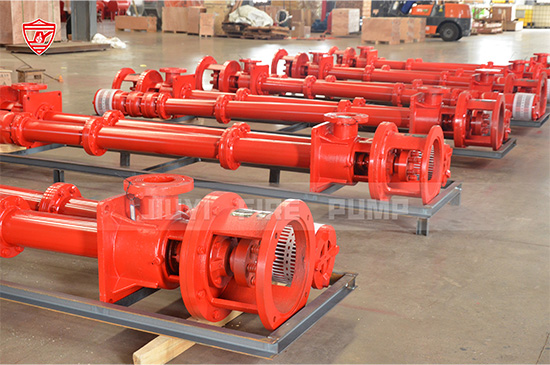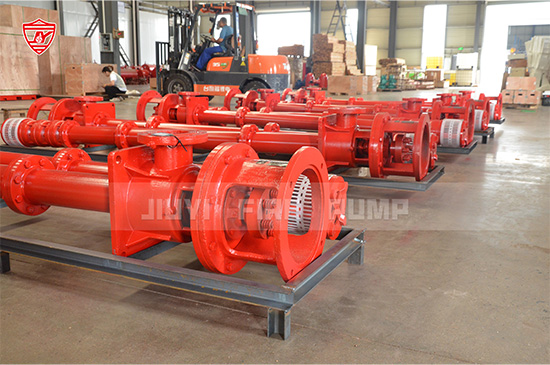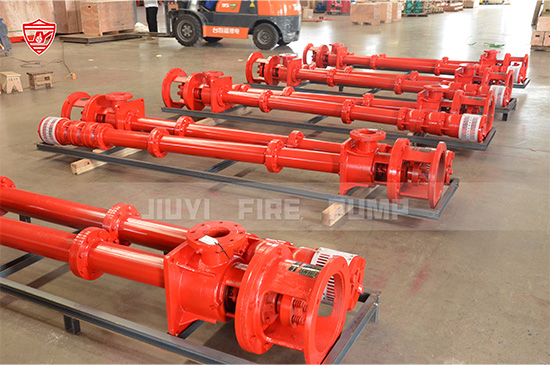Vertical turbine pumps (VTPs) are critical components in fire protection systems, widely used for high-capacity water supply applications such as industrial facilities, high-rise buildings, power plants, and oil & gas terminals. As a key part of NFPA 20-compliant fire pump systems, their reliability directly impacts safety and regulatory compliance.
However, like all mechanical equipment, vertical turbine fire pumps require regular inspection, preventive maintenance, and timely overhauling to ensure peak performance. One of the most common questions from engineers, facility managers, and safety professionals is:
“How often should a vertical turbine pump be overhauled?”
In this article, we will explain the recommended overhauling time, influencing factors, and expert maintenance practices to maximize your pump’s efficiency and lifespan.

Vertical turbine pumps are designed to lift water from deep sources, such as underground tanks, rivers, reservoirs, or wells. In fire protection systems, they are often used where large water volumes are required quickly under high pressure.
Key components of a typical vertical turbine pump include:
Pump Bowl Assembly (impellers, suction bell, and column bearings)
Pump Column (line shaft, bearings, and column pipe)
Driver Assembly (electric motor or diesel engine)
Discharge Head (stuffing box, mechanical seal, thrust bearings, and couplings)
Because of their submerged impellers and vertical shaft design, VTPs require specific maintenance schedules and overhauling intervals compared to horizontal fire pumps.
Pump overhauling involves a detailed inspection, cleaning, and replacement of worn-out parts to restore the pump to optimal operating condition. Unlike routine preventive maintenance, which focuses on lubrication, alignment, and minor adjustments, overhauling is a more comprehensive process that may include:
Disassembling the pump and inspecting all components
Checking shaft straightness and wear
Inspecting and replacing bowl and line shaft bearings
Examining impellers for erosion, corrosion, or cavitation damage
Replacing gaskets, seals, and packing
Balancing rotating components
Reassembling and testing the pump
Overhauling ensures the pump continues to meet NFPA 20 standards and delivers reliable performance during fire emergencies.
The typical overhauling interval for a vertical turbine pump used in fire protection systems is:
Every 5 years → Standard Recommendation under NFPA guidelines
Every 3 years → For pumps operating under harsh conditions (e.g., seawater, high sediment levels, or extreme temperatures)
Every 7 years → For pumps installed in clean-water environments with low operational hours
However, these timelines are not absolute. The actual overhauling schedule should be determined by:
Operating conditions – Water quality, temperature, and sediment levels significantly affect wear.
Pump duty cycle – Continuous-duty pumps require earlier overhauls than standby fire pumps.
Inspection results – Findings during annual inspections may indicate the need for earlier overhauling.
Manufacturer’s recommendations – Always follow OEM guidelines for your specific model.
Even with scheduled maintenance, certain signs indicate it’s time to overhaul your pump:
Reduced water flow or pressure during testing
Longer start-up times
Increased vibration or noise
Excessive bearing wear or overheating
Shaft misalignment or excessive runout
Worn or damaged impellers
Seal failure around the stuffing box
Persistent packing leaks
Unusual water leakage near column bearings
If any of these symptoms are detected, you should not wait for the next scheduled overhaul; immediate inspection and service are required.

A well-structured maintenance plan helps extend the overhauling interval and reduces costly downtime. The table below summarizes the difference:
| Aspect | Preventive Maintenance | Pump Overhauling |
|---|---|---|
| Frequency | Monthly / Quarterly / Annual | 3–7 years, depending on conditions |
| Scope | Lubrication, alignment, seal checks | Full disassembly and part replacement |
| Goal | Prevent early wear and tear | Restore pump to near-original condition |
| Cost | Lower | Higher |
| Downtime | Minimal | Longer |
A good preventive maintenance program can significantly delay the need for a full overhaul and reduce operational costs.
NFPA 20 provides baseline inspection and testing schedules. Combining these with OEM-specific recommendations ensures compliance and safety.
Conduct weekly and annual pump tests to monitor flow, pressure, and overall performance. Unexpected drops in capacity often indicate wear.
High sediment levels accelerate bearing and impeller damage. If water sources are contaminated, install strainers or sand separators to protect the pump.
Always use recommended lubricants for line shaft bearings and ensure oil levels are checked regularly. Lack of lubrication is a leading cause of premature failure.
Install vibration sensors on the discharge head to detect early signs of imbalance or misalignment. Early detection can prevent major failures.
Keep critical spare parts on hand, such as bearings, gaskets, and impellers, to reduce downtime during overhauling or emergency repairs.
Scenario:
A chemical plant installed a vertical turbine fire pump rated at 2,500 GPM with a diesel engine driver. After five years, performance tests showed a 15% drop in discharge pressure.
Findings During Overhaul:
Line shaft bearings were heavily worn due to poor lubrication
Impeller edges showed cavitation damage
Packing seals had degraded, causing leakage
Action Taken:
Replaced worn bearings and seals
Machined and balanced impellers
Installed upgraded lubrication system
Outcome:
The pump regained its original performance levels, and the plant extended the next overhauling interval to six years due to improved maintenance practices.
For fire protection systems, compliance with NFPA 20 and local fire codes is mandatory. Insurance providers and safety regulators often require documented maintenance records, including pump overhauls.
Annual fire pump testing must be logged.
Overhauling reports should include inspection details, replaced parts, and test results.
Failure to comply may lead to insurance claim issues in case of fire damage.

The overhauling time of a vertical turbine pump depends on operating conditions, maintenance practices, and regulatory requirements. While 5 years is the general industry recommendation, adopting a proactive preventive maintenance program can extend intervals, reduce costs, and improve system reliability.
For facilities relying on vertical turbine fire pumps, scheduling timely overhauls is not just about avoiding breakdowns—it’s about ensuring safety, compliance, and peace of mind.